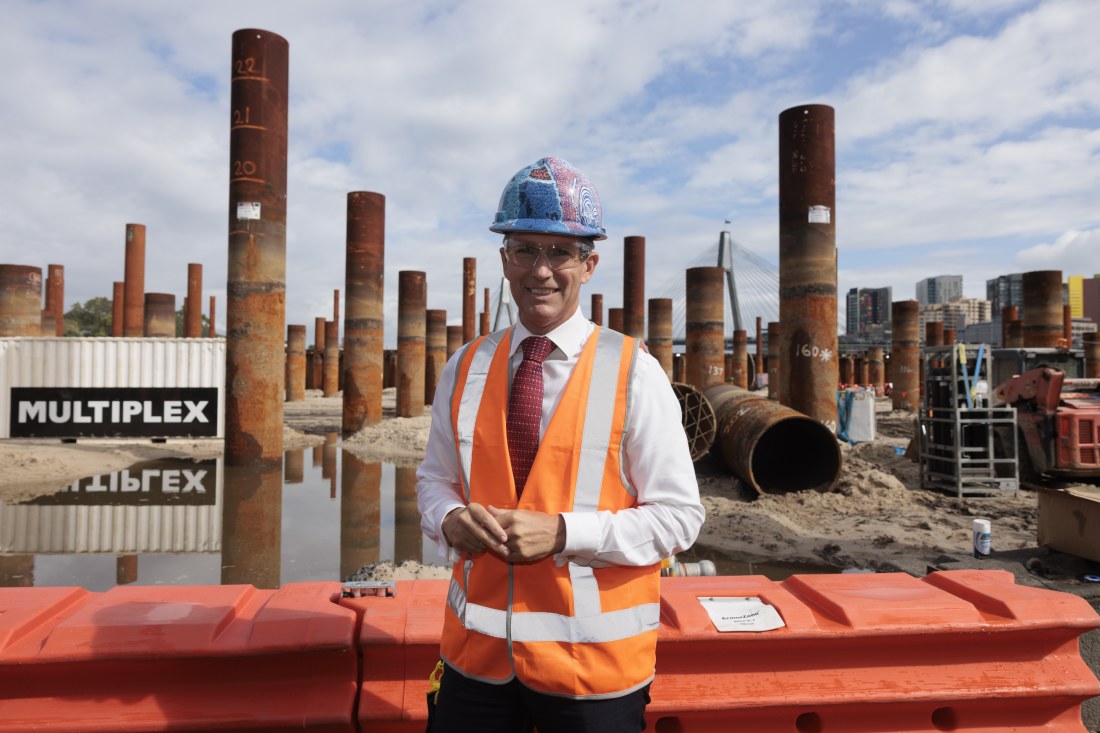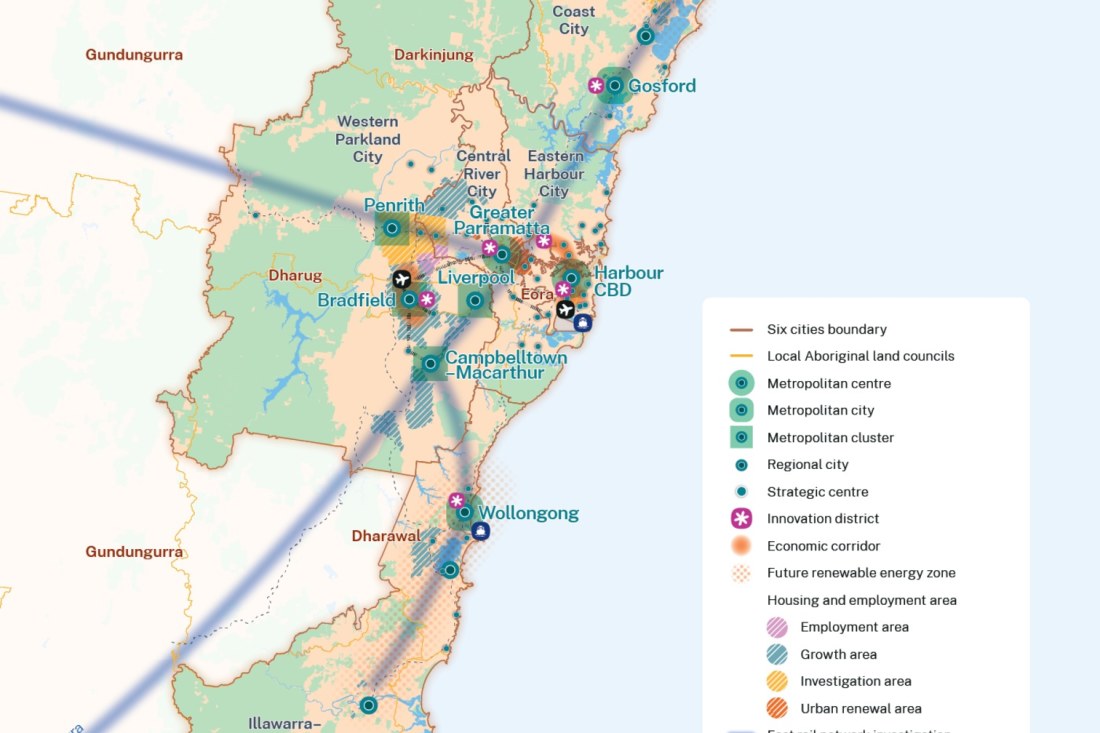Council opposition (along with that from a hostile state government and developers who wanted the land released for housing) led to the failure of the 1951 Cumberland Plan, also known as Cumberland County Council Scheme, to develop a green belt around Sydney’s existing urban footprint and prevent urban sprawl.
That was replaced by the 1968 Sydney Region Outline Plan that abandoned the idea of a green belt and focused on development in finger-like corridors stretching out from the established centre. But this functioned only as a system of principles and had no way of enforcing its ideas at the local level.

Former NSW planning minister Rob Stokes: “There are a lot of reasons why three to six levels is really good but there will also be constraints.” Brook Mitchell
As Stokes puts it, the Cumberland Plan was “too bottom-up” – as the state government didn’t like not being in control – while its 1968 successor was “too top down” and didn’t have local council buy-in.
The Greater Cities Commission – changed by the former Liberal government in 2022 from the Greater Sydney Commission – tries to get that balance right by including both state government and council representation, Stokes says.
“The Greater Cities Commission attempted to get the Goldilocks solution – not too top-down, not too bottom-up,” he says.
The twin hurdles
Geography and immigration have long made planning in Sydney harder. Meyer, Cox Richardson’s director of planning, said in a 2014 speech that Parramatta would have become the centre of settlement after white settlement if the Parramatta River had been deeper.
“It is very likely Parramatta would have been declared the main centre of Sydney,” he told a Sydney Architecture Festival audience. “As the ships’ keels kissed the river bed mid-point – hence the name Kissing Point – they could not proceed upstream.”
Faster than expected immigration and household formation has also made planning harder. The Cumberland Plan forecast the city’s population would grow from 1.7 million in 1947 to 2.25 million by 1981, a figure it reached in 1961 as a result of the postwar baby boom and immigration, Mayer says.
The 1968 plan did a better job of predicting growth, but it forecast the city would need to house 5 million people by 2000. By 2001, the city’s population had reached 4 million, but because of a decline in the household occupancy rate from the expected 3.2 people per household to 2.6 per cent, there still weren’t enough homes, Mayer says. “The houses were there – the houses took all the space the Sydney Region Outline Plan had reserved for residential development.”
The commission’s head of strategic planning, Stephanie Barker, says the planning body is working closely with councils and the state government in developing plans for the development of Sydney across six distinct cities stretching from Lower Hunter and Greater Newcastle in the north to Illawarra-Shoalhaven in the south.

A map of the Six Cities Region proposed by the Greater Cities Commission, which will replace the earlier plan for a three-city metropolis. Greater Cities Commission
The plans, once finalised, will replace the former Greater Sydney Commission’s idea of a three-city metropolis.
“We work closely with local government at every stage of the development of our region and city plans to understand local priorities and incorporate their existing work into our planning,” Barker says.
“Importantly, it is local councils who bring many critical elements of the plans to life. All 33 Sydney Councils have up-to-date local housing strategies for the first time in more than a decade.”
But how do they make those plans happen? A history of short-term thinking and poor development has poisoned the well of policy and planning, one veteran architect says.
“What’s been broken is the social contract between the development industry, the governance/authorities that do the planning and the local communities,” the architect says.
Perilli agrees with the criticism but says the pendulum has swung the other way.
“There are far too many projects that could have been a hell of a lot better,” he says. “It’s 1685518628 politically popular just to oppose development. It’s become too easy just to rail against development when people don’t know what they are railing against.”
Strategies and targets for new housing need to be enforced but that can’t be done by state governments taking over from local councils, as that would only deepen the distrust, says Ashleigh Ryan, a director with planning consultancy Urbis.
“Having the state government ‘take over’ from councils would potentially further increase anti-development sentiment at a local level, and we need to be thoughtful in demonstrating to existing communities the good outcomes that density can deliver,” Ryan says.

Ashleigh Ryan supports “legislating minimum densities or non-discretionary development standards”.
State planning controls need to be simplified to encourage simple assessment of good developments and to deliver quick or certain timeframes for development, she says.
“It’s not about taking power away from councils, but about reining in the hundreds of pages of controls that they are currently using to limit and restrict new housing and empower councils to refine and guide the local controls that may be relevant to a local area, such as building materials, landscaping, and even street wall heights or setbacks if that is what defines a local character,” she says.
“In the absence of a widespread rollout of more complying development codes for housing across NSW, I do support legislating minimum densities or non-discretionary development standards set by the state for new housing in accessible areas, and then maintaining council’s role in determining the finer details of development as may be relevant to a local area.”
What sort of housing and where?
But there are still arguments about which sort of housing the city should focus on developing – and where.
The Greater Cities Commission proposes managing development and encouraging housing across the greater region, which the NSW Productivity Commission says flies in the face of building denser housing where people want to live – closer to the existing city centre.
“These plans prioritised growth outside of the existing, highly productive economic centres by setting jobs and housing targets across western Sydney, for example, rather than enabling more housing near existing jobs,” the Productivity Commission report says.
Perilli supports transit-oriented developments, high-rise housing clustered around heavy transport nodes such as the railway stations being developed for Sydney’s burgeoning rail network.
Stokes isn’t so keen on them, however.
“It’s politically easy to say we’ll do transit-oriented developments,” he says. “The problem is we end up with a bifurcated city of 60s bungalows and massive towers and nothing in between.”
The problem with developing the “in between”, housing in medium-density developments of three to six storeys, is that the requirements that kick in for housing over three storeys, such as disability access requirements and fire standards make medium-density housing more expensive per dwelling than for apartments in tall towers.
“The costs start to escalate. There are some feasibility challenges that kick in,” Stokes says.
“There are a lot of reasons why three to six levels is really good but there will also be constraints that make them really hard to do.”
